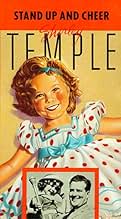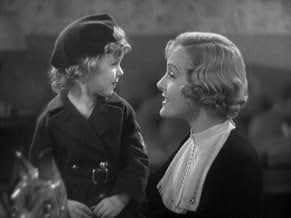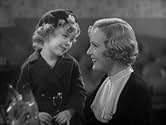Aggiungi una trama nella tua linguaA little girl's (Shirley Temple) toe-tapping musical numbers uplift the nation during the Depression in this charming classic that includes Temple's rendition of "Baby Take a Bow.A little girl's (Shirley Temple) toe-tapping musical numbers uplift the nation during the Depression in this charming classic that includes Temple's rendition of "Baby Take a Bow.A little girl's (Shirley Temple) toe-tapping musical numbers uplift the nation during the Depression in this charming classic that includes Temple's rendition of "Baby Take a Bow.
- Regia
- Sceneggiatura
- Star
- Premi
- 2 vittorie totali
- Aunt Jemima
- (as 'Aunt Jemima')
- Senator Danforth
- (as Mitchell)
- Senator Short
- (as Durant)
- Nick Foran
- (as Nick Foran)
- Hill-Billy
- (as 'Skins' Miller)
- Dancer
- (non citato nei titoli originali)
- Dancer
- (non citato nei titoli originali)
Recensioni in evidenza
Well maybe that story got back to the ears of Will Rogers because he was the one who came up with the idea of a Cabinet position for Secretary of Amusement. Maybe Rogers had himself in mind for the job, he was sure doing it unofficially.
Fox was Rogers's home studio, but he makes no appearance here. Instead the president of the United States hires Warner Baxter for that job.
Baxter essentially reprises his role of Julian Marsh the driven director from 42nd Street. I guess the money from that hit show didn't last long for Baxter so he's got this job.
But can you imagine; instead of trying to get financial backers for a show, Baxter goes before a Congressional committee for an appropriation? I'm not sure which is a worse ordeal.
So the movie is Baxter trying to find a talent enough for a big extravaganza that will do what Herbert Hoover wanted from only one song.
Stand Up and Cheer survives today because of the appearance of Shirley Temple, on her way to becoming the movies' biggest box office attraction of the decade. She only does one number here, with hoofer James Dunn as her father. But it's one of her biggest, Baby Take a Bow.
If it weren't for Shirley, the film would have been a curious forgotten relic of some very tough times. Still it's worth watching for more than just Shirley Temple.
Warner Baxter had the main role as "Lawrence Cromwell." He was assisted by his secretary played by a very pretty Madge Evans, whom I didn't know until trying to find out on this website because the video box doesn't even have her listed in the billing.
The rest of the cast included a couple of people I was familiar with from other roles, such as Nigel Bruce, who played Dr. Watson to Basil Rathbone's Sherlock Holmes. We also have a lady who played Aunt Jemima and Stepin Fetchit, both a couple of embarrassing stereotypes of the period. I was never a fan of Fetchin, not for PC reasons but simply because of his whiny voice and stupid characters he played. He was the same here except when he dove into a fish tank, which made gave me a big laugh.
This film had a good share of strange characters but, despite that, overall isn't anything that memorable....perhaps because Shirley had such a small role.
It is always vital when examining old films to try to be sensitive to their context within their own time frames. Important movies of 70 years ago may look terribly trite now through absolutely no fault of their own. Judging by today's standards can often lead to pitfalls.
That having been stated, however, it is difficult to appreciate this film without seeing it for what it is: undeniably silly. And racist. And even a bit bizarre at times. But it contains one great jewel...
Earnest Warner Baxter & lovely Madge Evans certainly give the plot a try, but the script is dead set against them all the way, making him encourage hillbilly singers as the remedy for the nation's economic woes and having her mope about lovelorn & lonely.
As Aunt Jemima, blackfaced singer Tess Gardella (very popular at the time on Broadway's Show Boat) and especially Stepin Fetchit are embarrassingly stereotyped. It should be noted, however, that this sort of racial belittlement was not unusual in the Hollywood of the 1930's.
The physical, knockdown humor of Frank Mitchell & Jack Durant, playing a couple of zany U. S. Senators, is very odd & no longer funny. Odder still is the penguin that thinks he's Jimmy Durante.
Familiar faces show up from time to time - Nigel Bruce, Ralph Morgan, little Our Gang kid Scotty Beckett, warbling John Boles - but they are quickly submerged by the plot.
In the midst of all this clutter of mismatched parts, when all might be given up for lost, comes five-year-old Shirley Temple and she is an utter joy.
Shirley had already appeared in a series of features & shorts. But it was here, singing & dancing - and completely obliterating poor James Dunn who played her father - that the situation was ripe for her to march straight into the nation's heart. In 1935 Shirley would begin to star in her string of classic family films, and, with the death of Marie Dressler in July of 1934, the mighty moppet was to begin her reign as Hollywood's number one box office attraction.
So, with the arrival of Shirley Temple, we do indeed have much for which to STAND UP AND CHEER!
Take, for example, the show-stopping finale to "I'm Laughing," performed by Tess Gardella. There are a series of tableaux in this number, of various individuals all representing different marginalized groups: Immigrants, sweatshop workers, laborers of all kinds, all leading up to Tess Gardella herself busting out with the biggest, cheeriest performance of all, surrounded by a rousing, dancing chorus. It was clearly meant to recap the song's theme--if I can laugh, as downtrodden as I am, so can you--and to embody those who persevere and triumph over circumstance. With a swish of her ample hips and a gleam in her eye, Ms. Gardella triumphs.
The standard Stepin Fetchit routine has been analyzed everywhere, but let me just add that in this picture, the actor personifies African American resistance. In 1934 Black men were still not free from the vicious system of racial etiquette known as Jim Crow, and were therefore limited in the number of personae they were allowed to display. The genius of Stepin Fetchit is that he acts out the prescribed social role while frustrating those who prescribe it by withholding his intelligence and personality from the social interaction altogether. He slyly gives white people exactly what they demand,nothing more, forcing them to realize that perhaps that's not what they want after all. The resistance is his and the joke is on them.
Lo sapevi?
- QuizFor the "Baby, Take a Bow" number with James Dunn, the studio felt it would be easier for Shirley Temple to do the dance she had done at her audition rather than learn a new one, so Temple spent her first day on the set giving Dunn dancing lessons.
- Citazioni
Lawrence Cromwell: Now, Miss Monroe...
Mary Adams: Er, Adams.
Lawrence Cromwell: Oh, yes, step here a minute, will you, please... something I want to show you. There's one phase in this amusement campaign which I think you ought to understand. The zones in...
[overcome by her good looks, he stops]
Lawrence Cromwell: You're beautiful.
Mary Adams: Ah, of course I'm not.
Lawrence Cromwell: What's that?
Mary Adams: I said I'm not beautiful.
Lawrence Cromwell: Young woman, you're talking to Lawrence Cromwell... Lawrence Cromwell, the world's recognized authority on feminine beauty and charm. Do you mean to stand there and question my judgment on the subject of beauty? Do you? Do you?
Mary Adams: Oh, no, no, I wasn't...
Lawrence Cromwell: Oh, but you DID question it. Now, you listen to me: when Lawrence Cromwell says a girl's beautiful, she's BEAUTIFUL, do you understand? Ha, the very idea! I demand an apology. Your personality definitely puts you in Class 10-A, Department B, with a double-X rating in my card index system. And, my system is the pre-eminent beauty catalogue of today.
[sizing her up at a glance]
Lawrence Cromwell: Height, 5 foot 4... weight, 116... bust, 34... waist, 26... hips, 36... calf, 12 and 1/2... ankle, 7. Questioning my judgement! Ha, ha, that is good.
Mary Adams: I'm really awfully sorry, Mr. Cromwell.
Lawrence Cromwell: Never mind, never mind, just... just let it be a lesson to you.
- Versioni alternativeDifferent versions of this film exist, with various running times between 68 and 81 minutes. Some prints have deleted demeaning & outdated cultural depictions of African Americans that are offensive to modern audiences, including scenes with _Stepin Fetchit_ and _Tess Gardella_ in blackface as "Aunt Jemima".
- ConnessioniFeatured in Non siamo più bambini (1940)
- Colonne sonoreStand Up And Cheer!
(1934) (uncredited)
Lyrics and Music by Lew Brown and Harry Akst
Sung by over the end credits
Instrumental over the title sequence and beginning credits
c. 1934 Movietone Music Corportation
I più visti
- How long is Stand Up and Cheer!?Powered by Alexa
Dettagli
- Data di uscita
- Paese di origine
- Lingua
- Celebre anche come
- Stand Up and Cheer!
- Azienda produttrice
- Vedi altri crediti dell’azienda su IMDbPro
- Tempo di esecuzione1 ora 8 minuti
- Colore
- Proporzioni
- 1.37 : 1
Contribuisci a questa pagina




































